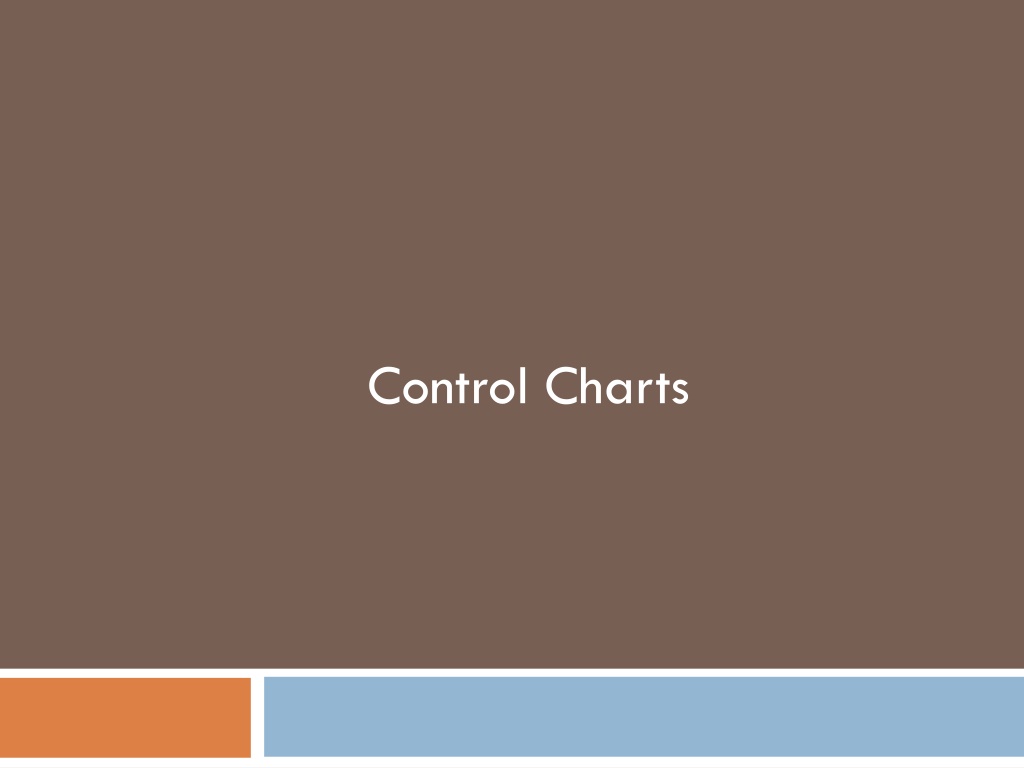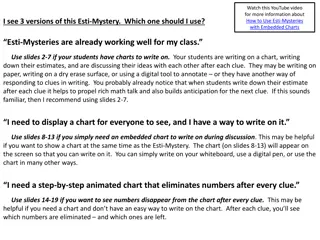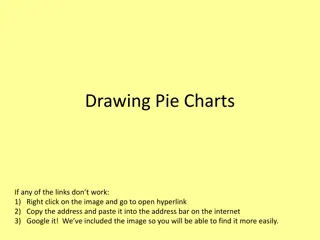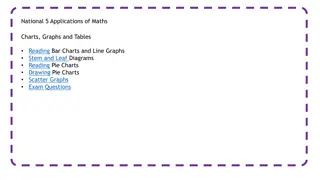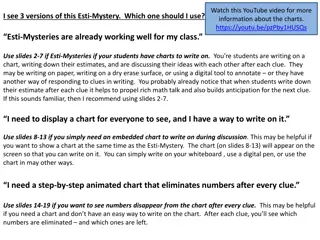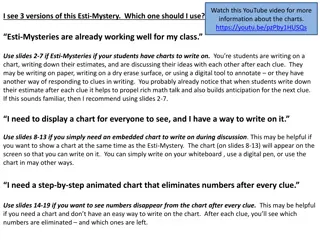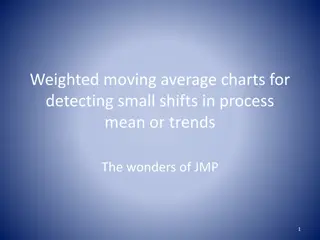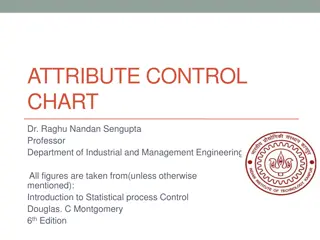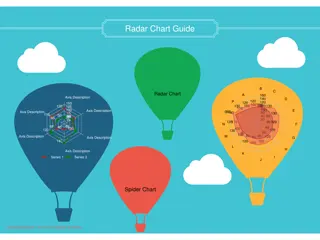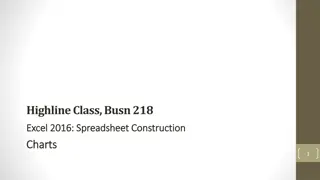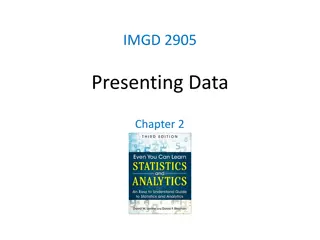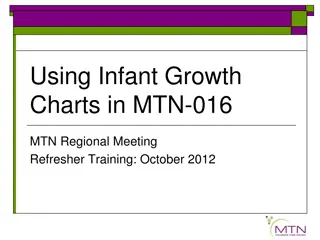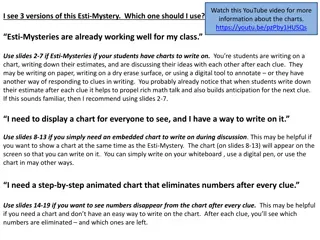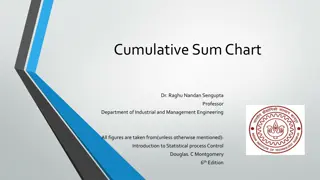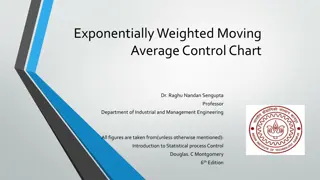Understanding Control Charts: Tools for Process Monitoring
Control charts are essential tools in statistical process control systems. They help distinguish between natural and assignable variations in a process. By monitoring sample statistics and setting control limits, organizations can detect issues and take corrective actions promptly. This comprehensive guide covers the purpose, construction, steps in creating control charts, and specific types like x-charts for variables. Learn how to interpret control charts and ensure the stability and quality of processes using statistical methods.
Download Presentation

Please find below an Image/Link to download the presentation.
The content on the website is provided AS IS for your information and personal use only. It may not be sold, licensed, or shared on other websites without obtaining consent from the author. Download presentation by click this link. If you encounter any issues during the download, it is possible that the publisher has removed the file from their server.
E N D
Presentation Transcript
Statistical Process Control The objective of a process control system is to provide a statistical signal when assignable causes of variation are present
Control Charts Constructed from historical data, the purpose of control charts is to help distinguish between natural variations and variations due to assignable causes
Steps In Creating Control Charts 1. Take samples from the population and compute the appropriate sample statistic 2. Use the sample statistic to calculate control limits and draw the control chart 3. Plot sample results on the control chart and determine the state of the process (in or out of control) 4. Investigate possible assignable causes and take any indicated actions 5. Continue sampling from the process and reset the control limits when necessary
Control Charts for Variables For variables that have continuous dimensions Weight, speed, length, strength, etc. x-charts are to control the central tendency of the process R-charts are to control the dispersion of the process These two charts must be used together
x-charts For x-Charts when we know Upper control limit (UCL) = x + z x Lower control limit (LCL) = x - z x where x = mean of the sample means or a target value set for the process z = number of normal standard deviations x= standard deviation of the sample means = / n = population standard deviation n = sample size
x-charts - Example The weights of boxes of Oat Flakes within a large production lot are sampled each hour. 12 different samples where selected and weighted and the average of each sample is presented in the following table. Each sample contains 9 boxes and the standard deviation of the population is 1. Managers want to set control limits that include 99.73% of the sample mean. Hour Sample average of 9 boxes Hour Sample average of 9 boxes 1 16.1 7 15.2 2 16.8 8 16.4 3 15.5 9 16.3 4 16.5 10 14.8 5 16.5 11 14.2 6 16.4 12 17.3
x-charts - Example For 99.73% control limits, z = 3 UCLx= x + z x= 16 + 3(1/3) = 17 ounces LCLx= x - z x= 16 - 3(1/3) = 15 ounces
x-charts - Example Control Chart for sample of 9 boxes Variation due to assignable causes Out of control 17 = UCL Variation due to natural causes 16 = Mean 15 = LCL Variation due to assignable causes | | | | | | | | | | | | 1 2 3 4 5 6 7 8 9 10 11 12 Out of control Sample number
Patterns in Control Charts Upper control limit Target Lower control limit Normal behavior. Process is in control.
Patterns in Control Charts Upper control limit Target Lower control limit One plot out above (or below). Investigate for cause. Process is out of control.
Patterns in Control Charts Upper control limit Target Lower control limit Trends in either direction, 5 plots. Investigate for cause of progressive change.
Patterns in Control Charts Upper control limit Target Lower control limit Two plots very near lower (or upper) control. Investigate for cause.
Patterns in Control Charts Upper control limit Target Lower control limit Run of 5 above (or below) central line. Investigate for cause.
Patterns in Control Charts Upper control limit Target Lower control limit Erratic behavior. Investigate.
x-charts For x-Charts when we don t know Upper control limit (UCL) = x + A2R Lower control limit (LCL) = x -A2R where R = average range of the samples A2= control chart factor found in the Table in the next slide x = mean of the sample means
Control Chart Factors (3 sigma) Sample Size n 2 3 4 5 6 7 8 9 10 12 Mean Factor Upper Range A2 1.880 1.023 .729 .577 .483 .419 .373 .337 .308 .266 Lower Range D3 D4 3.268 2.574 2.282 2.115 2.004 1.924 1.864 1.816 1.777 1.716 0 0 0 0 0 0.076 0.136 0.184 0.223 0.284
x-charts - Example Super Cola bottles soft drinks labeled net weight 12 ounces . Indeed, an overall process average of 12 ounces has been found by taking many samples, in which each sample contained 5 bottles. The average range of the process is 0.25 ounces. We want to determine the upper and lower control limits for averages in this process.
x-charts - Example Process average x = 12 ounces Average range R = .25 Sample size n = 5 UCLx = x + A2R = 12 + (.577)(.25) = 12 + .144 = 12.144 ounces UCL = 12.144 Mean = 12 LCLx = x -A2R = 12 - .144 = 11.857 ounces LCL = 11.857
RChart Type of variables control chart Shows sample ranges over time Difference between smallest and largest values in sample Monitors process variability Independent from process mean
RChart For R-Charts Upper control limit (UCLR) = D4R Lower control limit (LCLR) = D3R where R = average range of the samples D3and D4= control chart factors from the previous Table - Control Chart Factors (3 sigma)
RChart - Example The average range of a product at the National Manufacturing Co. is 5.3 pounds. With a sample size of 5, the owners want to determine the upper and lower control chart limits for the range UCLR = D4R = (2.115)(5.3) = 11.2 pounds UCL = 11.2 Mean = 5.3 LCLR = D3R = (0)(5.3) = 0 pounds LCL = 0
Mean and Range Charts (a) These sampling distributions result in the charts below (Sampling mean is shifting upward but range is consistent) UCL (x-chart detects shift in central tendency) x-chart LCL UCL (R-chart does not detect change in mean) R-chart LCL
Mean and Range Charts (b) These sampling distributions result in the charts below (Sampling mean is constant but dispersion is increasing) UCL (x-chart does not detect the increase in dispersion) x-chart LCL UCL (R-chart detects increase in dispersion) R-chart LCL
